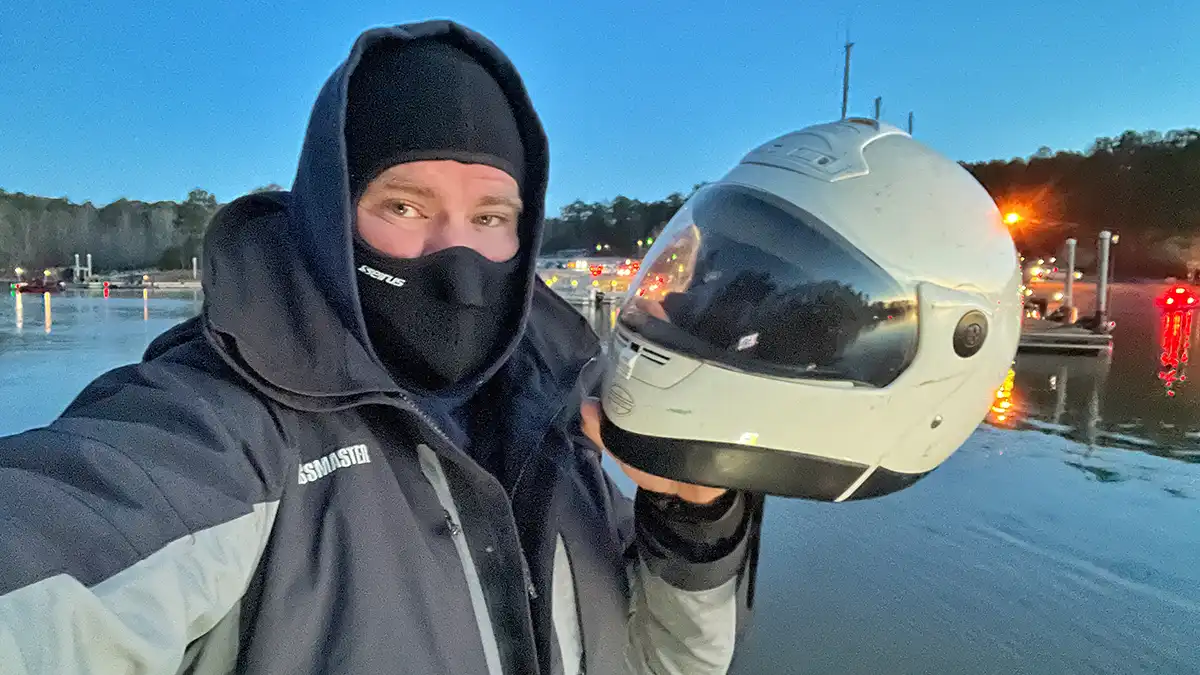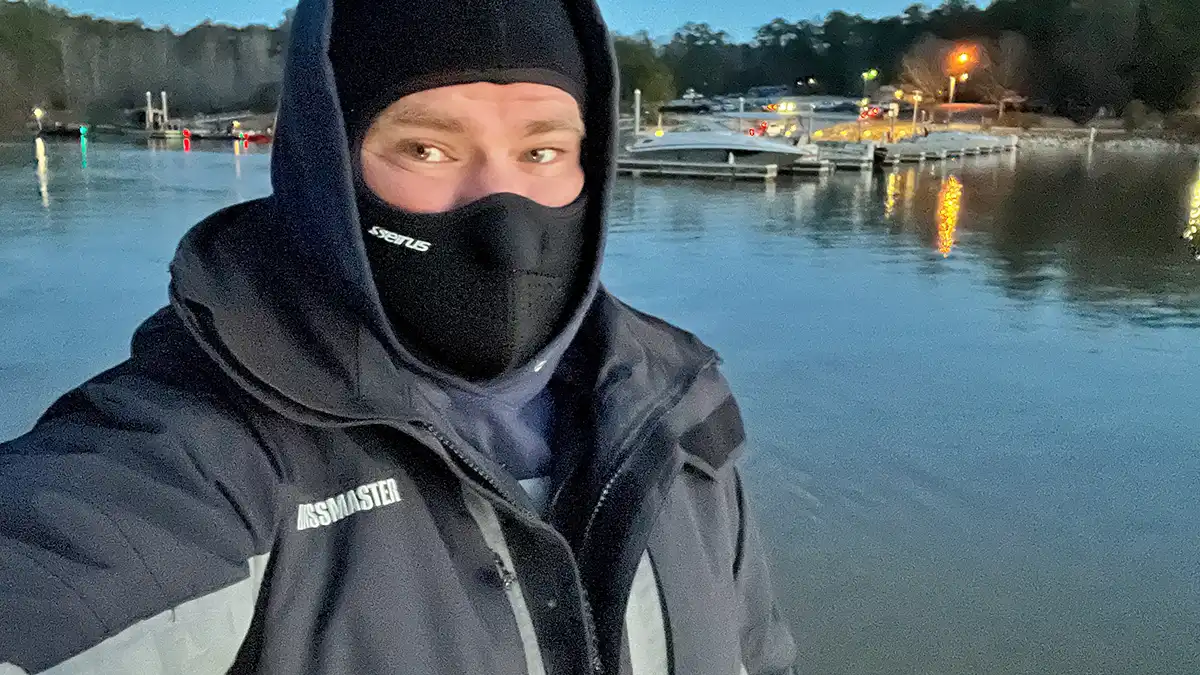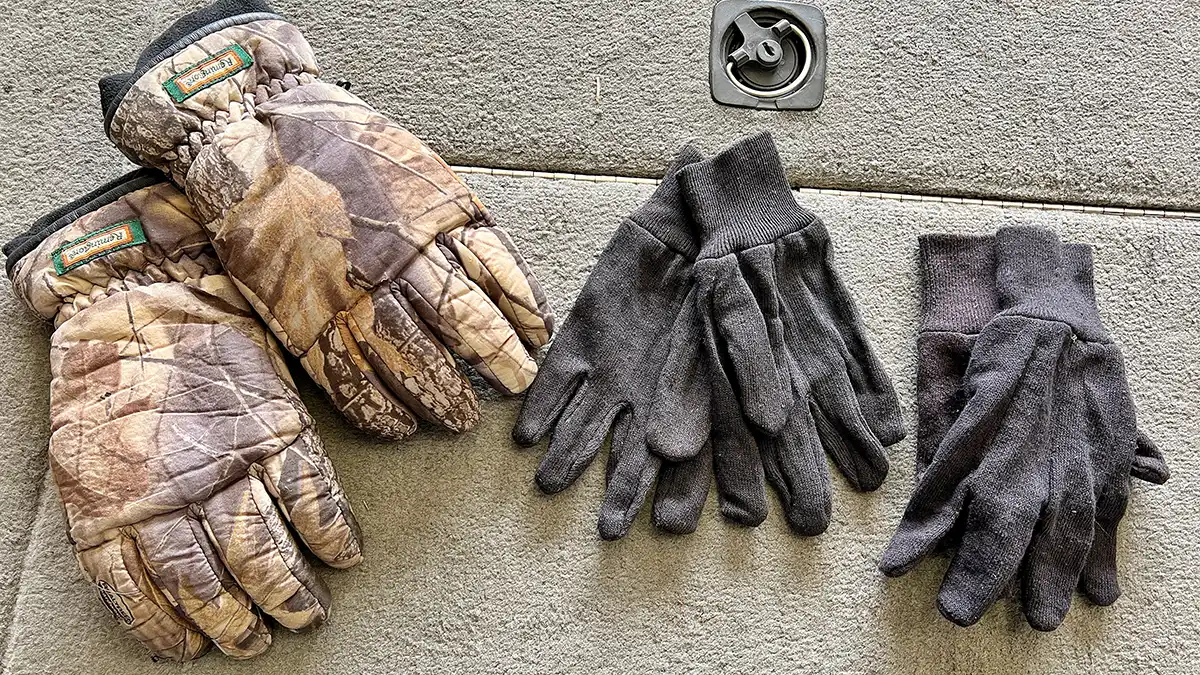I’m not a big fan of cold weather. To be fair though, I’m not really that big of a fan of hot weather either. I like that 72-degree life; jeans and a hoody, that’s what I’m believing heaven will be like. That being said, I would still probably take the extreme cold over the extreme hot—at long as the boundary of extreme cold still allows for fishing open water in a bass boat.
On a recent trip with my dad, we were teetering on that boundary of extreme cold. The water was well above freezing, hovering around 46. But the morning air temps were in the mid-20s and the rod guides repeatedly clogged with ice for the first couple hours, despite our best efforts to keep them cleared.
While going through the routine that morning of bundling up for the bitter day ahead, it came to me that dad and I have developed quite a system for weathering the cold. For those of you who don’t have decades of experience fishing through the winter, my hope is that these tips will help you better enjoy your time on the water when the temps drop. And my prayer is that this wisdom distilled from the wise men before me will even save your life in an emergency situation.
One last precursor to this piece, this isn’t a scientific approach as much as it is a redneck’s guide to not freezing your butt off. There are companies that make fantastic products with fantastic claims about how this material wicks moisture or that material insulates better at a fraction of the weight. All of that may be well and true. And while there are some expensive items in my cold weather wardrobe (most that I’ve been given to test), I believe anyone could take these tips and build a system that works for them on a budget. Here we go.
LAYERING
When looking at dressing for the cold, layering is extremely important. I’d wager a thin shirt, a hoody and a wind breaker would keep you warmer than one big puffy goose down jacket on your bare skin. Putting on multiple layers of clothes helps trap air, and air is actually a great insulator.
I typically wear a shirt, a hoody and a jacket (sometimes two if one is a thinner rain jacket, primarily intended to prevent wind penetration). For the bottoms, I’ll put on a pair of joggers and a pair of jeans, then bibs. I really like my Aftco Hydronaut Insulated Bibs because they cover my whole torso. The back is made of a breathable mesh material to prevent sweating. But having a solid bib as opposed to pants does wonders for keeping wind from seeping under my jacket while running down the lake.
DON’T SWEAT IT
I like to wear thick socks when fishing in the cold, paired with waterproof/insulated boots, whether it’s raining or not. You can even double up two pair of thinner socks if you don’t have thicker ones. And the boots I’m currently wearing are the Xtratuf Men’s Ice Fleece Lined Ankle Deck Boot, which I’ve recently reviewed in detail.
One note here though that is extremely important, not only with all this gear but with the shoes in particular: do not suit up if you have a long drive to the ramp. One of the worst mistakes you can make when preparing to fish in the cold is to sweat before the day begins. I’ll actually wear other socks and shoes to the ramp, with just my base layer of clothes, and then suit up and put the thicker socks and boots on at the ramp.
And fight the urge even then on the way to have the heat on high in the truck. It’s better to be a little chilly on the car ride than to get to the lake warm and toasty, and then go straight from that to sub-freezing conditions.
HEAD GEAR
Taking care that your feet don’t get cold is extremely important. The feet are an extremity, meaning they are far from the heart. So, they get colder quicker than say the torso. The same is the case for your hands and your head. You should pay particular attention to covering these areas in the cold.
A balaclava is basically a combination of a toboggan hat and face mask. This is the best base-later option in my opinion for taking care of your head. The Aftco Reaper Softshell Jacket that I’m currently wearing actually has a built-in face mask for the cold, so I have the option to simply wear a toboggan with it and I’m good to go. But, if you’re just wearing a simple hoody or jacket, something like the Gill HT45 Polarclava is a great addition to your outfit.
PROTECT THE HANDS
When it comes to my hands, I have a two-pronged approach. While the boat is on plane, I’ll wear a pair of heavy gloves. These can be pretty basic, as long as they’re thick and block the wind. There are some gloves (like the Aftco Hydronaut Gloves) that still allow you to use the touchscreen on your graph, which is nice. But simple thick gloves will suffice for most of us.
Thick gloves though don’t work while you’re fishing, since they cut down on sensitivity and their bulkiness makes holding the rod and turning the reel awkward. Now, while there are all sorts of gloves on the market specifically design for use while actively fishing, I’ve yet to find the perfect pair to wear all day in the cold, for one simple reason: they all get wet.
Because of this, I’ve actually adopted a method that I picked up somewhere along the way from a fellow angler—I believe it was my buddy Neal. I’ll take a simple pack of brown gardening gloves and throw them in the boat. When I reach my first spot, I’ll peel off the big gloves and slide on a pair of these. They don’t stop the wind completely, but they do keep my hand from making direct contact with the ice cold metallic and plastic surfaces of the reel and rod.
And, when a pair get wet after about an hour, I simply toss them in the rod locker and pull out another pair. Usually by midday, the need for gloves while fishing has subsided. When I get home I can just lay them all out to dry and then they’ve ready fro the next trip. This works really well for me and it costs around 6 bucks for a pack of 12 online.
ODDS AND ENDS TO WARMTH
Using some sort of outer head covering to break the wind on the run is really helpful too. I’ve used a Save Phase in the past, and I’m currently using an old motorcycle helmet I inherited from Neal. Both work well, and there are lots of cheap options online for something like this.
Hot Hands are another extremely beneficial tool to have on hand, literally. These little packs of goodness can last through a whole day of fishing, and keeping a pair in your coat pockets creates the perfect retreat for your hands from time to time throughout the morning. This company also offers different sizes and models of their personal heaters that can be used on your back, feet and in other places susceptible to the cold.
PREPARE FOR DISASTER
It’s also very important when fishing in the cold to prepare for the worst. If you fall in the water, it can be hard to get back in the boat, and you can easily drown as heavy boots and thick clothes fill up with water. Even if you do make it back into the boat, hypothermia can set in within minutes.
It’s always a good idea to where a PFD while fishing, but it is essential when the weather and water temps are below 50 degrees. There are all sorts of affordable inflatable life vests now. In a world where anglers are spending $500 on a fishing reel and $100,000 on a bass boat, investing $100 into something that will last for years and will literally save your life in an emergency situation is a no-brainer.
A little ingenuity and awareness can go a long way too in the event of an emergency, and it’s better to think through these things with a clear mind instead of waiting until you’re under duress. If you’re boat has a ladder on it, familiarize yourself with its location and how to use it.
Thinking outside the box can save your life as well. My old buddy Neal fell out of his boat on a cold winter day a few years ago, in his late 70s. He was alone, and unable to reenter his boat under his own power. The Marine he was, he had the bright idea to hug the outboard and then trim it up, finally rolling onto the back deck when the motor was completely out of the water. He would have died that day had he not had that idea come to him.
But, if you do fall out of the boat, the fight for your life has really only just begun once you get back in it. Hypothermia can set in quickly, and you can’t always get back to the ramp or get inside a building in a hurry. Keeping a full set of dry clothes in the boat is an absolute must in the winter months. It’s not a bad idea to even keep a lighter in the boat so you can go ashore and build a fire, if you’re in a remote area where you can’t get to shelter.
I know this is a lot. But my hope is that these tips will not only make your days on the water in the winter more bearable, but they even might save your life in the event of an emergency. Remember to layer up, avoid sweating at all cost, take care of your extremities and be prepared for the worst. If you put these things into practice, you’ll find that fishing in the extreme cold isn’t all that bad at all.


















